
Disclaimer: Back in May of 2006, when I started posting about our vacation to the Hawaiian Islands, we were severely limited regarding photos I could share due to bandwidth limitations. Here in 2022, I’m updating these posts using the original image and text I shared, but I’m adding the rest of the photos I would have liked to share if bandwidth and storage had not been issues 16 years ago.
Woke up at sunrise for an early drive to Hilo as this was our last day on the Big Island of Hawaii.
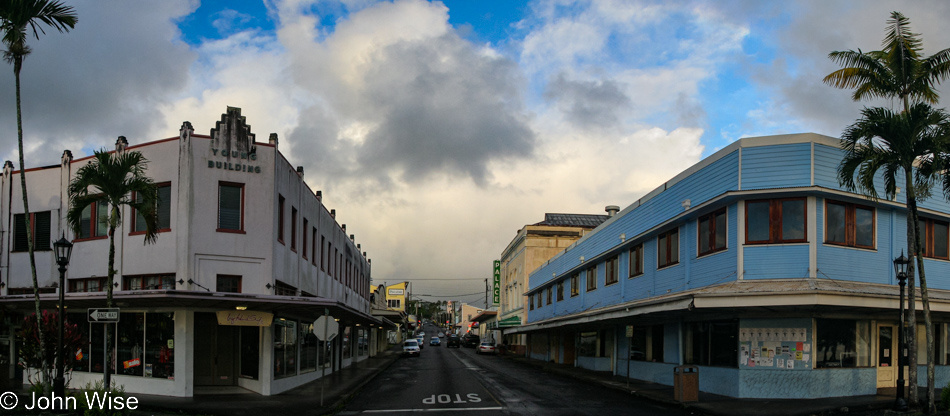
We certainly didn’t spend enough time here in town because we were too busy exploring the natural environment of the island and visiting the Merrie Monarch Festival.

And with that, we were gone and on our way to the next island of this tropical adventure.

Never even made it close to Mauna Kea, but maybe one day.

Along the way, we passed the barren island of Kaho‘olawe. This island was used by the U.S. military and a host of invited militaries as a bombing range. So effective are bombs at creating devastation that this island had 1200 feet of features blown off for eternity. The bombing also appears to have had the effect of cracking the island’s water table, dealing what would appear to be the final blow to this once-tropical island which already had been practically denuded by overgrazing goats and cattle in the early 1900s. Millions of dollars have been spent trying to clear unexploded ordnance and get life to take root again, to little avail. Oh well, no matter; who needs islands anyway? We can just build artificial ones as Japan and Dubai do.

And here we are on Maui. Our first stop was the rental car office, where we found out that no more economy cars were available for us and that we were “upgraded” to a 4-wheel-drive jeep “for free.” To the surprise of the clerk, we were less than pleased because we had hoped for a less gas-guzzling vehicle. However, this jeep would allow us to experience one of the top tourist destinations here in Maui, the “Road to Hana,” which leads to the eastern side of the island. On the way east, we passed Mantokuji, which is a Soto Zen Buddhist temple in Paia. The Japanese influence is readily apparent.

The famous Road to Hana is super scenic and very popular. A cruise ship must have arrived earlier today because we saw a number of identical rental jeeps en route. However, we took things slowly and let everyone else pass us by.
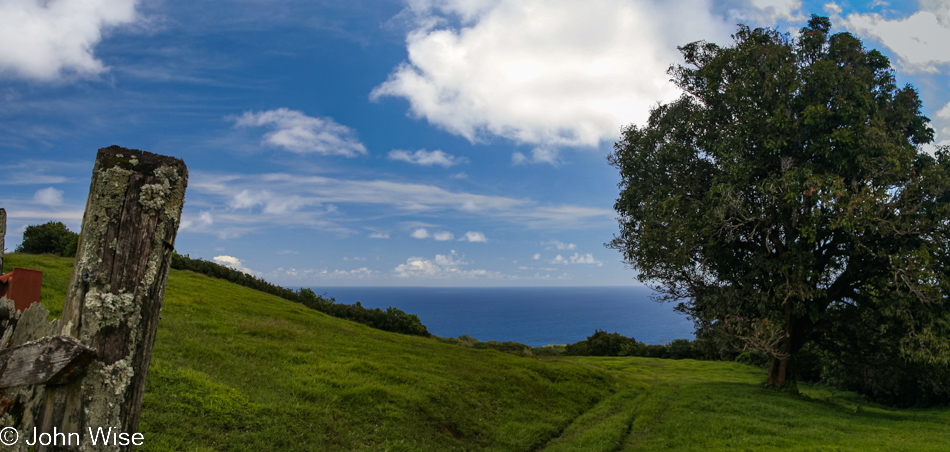
You’d think that a relatively tight cluster of islands out in the middle of the Pacific Ocean would produce nearly identical landscapes, and maybe it’s only due to the variations in terrain, but I’m getting the sense there are nuanced differences that I’m not yet able to put a finger on.

The great thing about the Kahului Airport here in Maui is that it’s on the edge of the city, meaning we didn’t have to step foot into town. This is a little luxury where, barely an hour after we left the Big Island, we were off in the wilds.
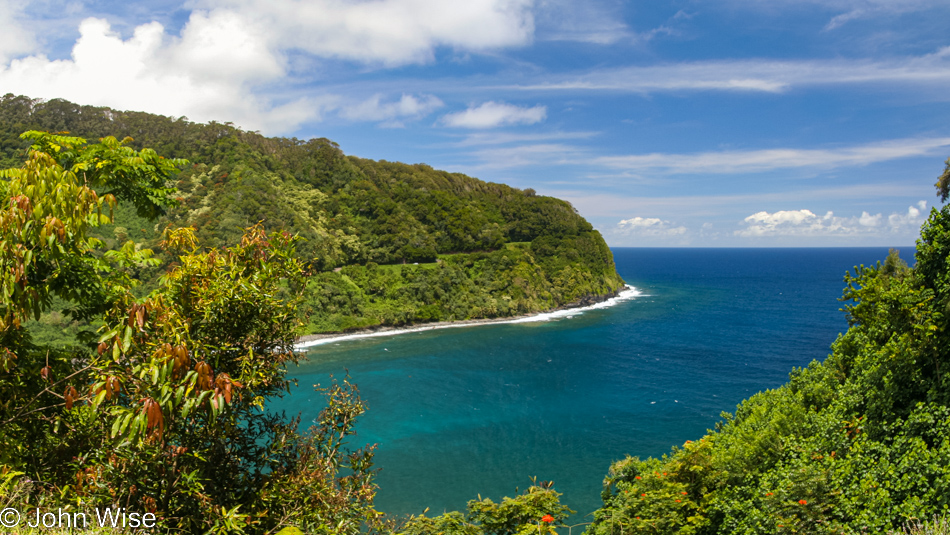
Somewhere back up the road, we passed Mile Marker Zero of the Road to Hana. I’m sure had we seen the marker, we’d have a selfie of ourselves in front of it, but there you are, spared another indulgent photo of the two of us.

Somehow we have traveled 18 miles since we passed the beginning of the Road to Hana as we stop at this famous Wailua Valley Lookout and take a photo a million before us have taken and 100 million will take in the future.

Upper Waikani Falls may not have been the first waterfalls along this road, but this was one of those days where we didn’t really know how long we might need for the drive, so we felt we needed to be frugal with the stops. Mind you, we were warned that it wasn’t allowed for us to take our rental vehicle past the end of the Road to Hana which made us a bit nervous as to what we’d find out there.

Finding banana bread and carrot juice at a roadside stop that asked visitors to do the honorable thing and leave the money in a box was a welcome surprise and a great gesture.

A flower from a plant in the Heliconia family also known as lobster-claws, toucan beak, wild plantain, or false bird-of-paradise.

That banana bread and carrot juice were snacks because just a bit further down the road was someone set up with a makeshift kitchen offering homemade traditional Hawaiian “plate lunch” that we would have devoured even if we’d just finished a dozen loaves of banana bread. This road is turning out to be a non-stop luxury.
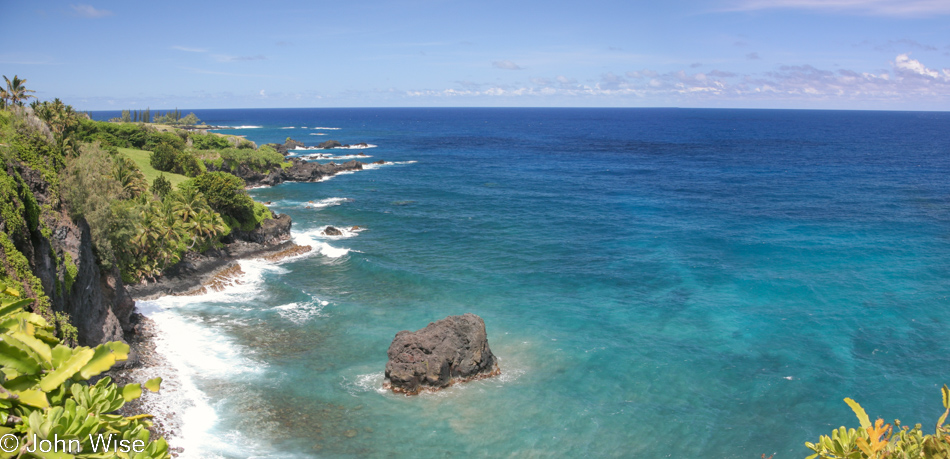
No time for siesta; we have more blue sky, azure and turquoise seas, and lush forests for us to see with our own eyes.

Here at Wailua Falls, we are definitely traveling south by now and are about 23 south further along from when we took the photo of Wailua Valley.
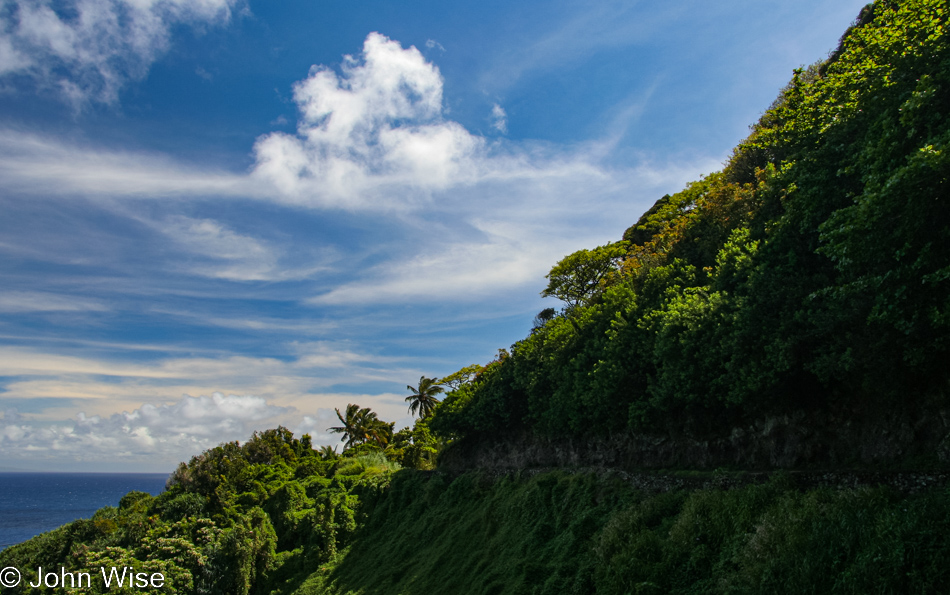
There, in the shadow carved into the steep cliff, is our road, believe it or not.

Entering Haleakalā National Park for a brief moment, tomorrow we’ll be visiting the top of the eponymous volcanic mountain that lent its name to the park.

The Pools of ‘Ohe’o, a.k.a. the Seven Sacred Pools south of Hana. We learned prior to leaving Arizona that these pools were one of the places we had to visit, but with so many others there before us and parking at a premium, we’re just thrilled we’ve had the chance to gaze upon them ourselves.

This is to note that these are the first ever bananas we’ve seen growing anywhere. Had they not been green, you can bet we would have picked a couple. Come to think about it, we should have anyway, as they would have ripened along the way.

And we just kept on going…

…even when I had to proceed with white knuckles and some courtesy horn beeping to let others know that we are nervously over here hugging the inside of what can, at times, hardly be called a road. No wonder the rental car companies don’t want you to take this drive all the way around the island!
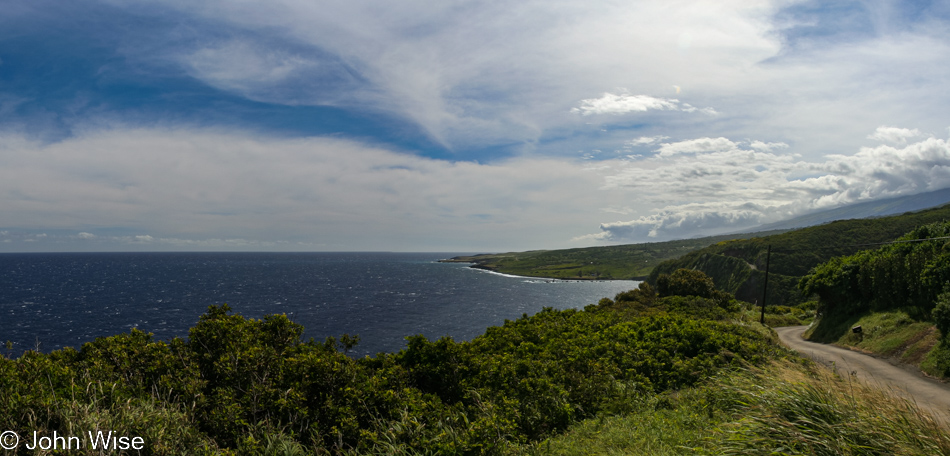
Overcome the anxiety, and on the other side, we find perfection.
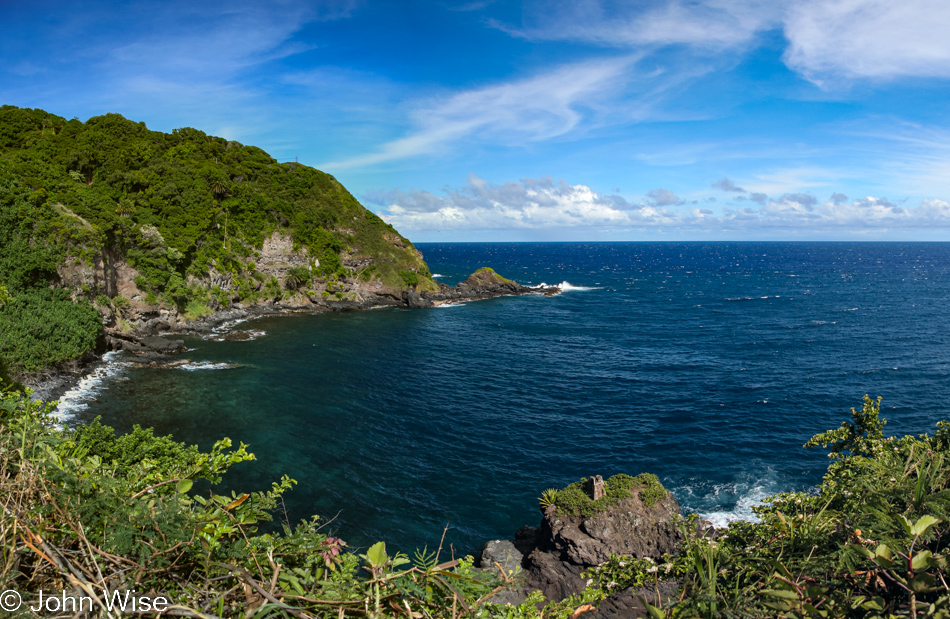
There is something about the places where land meets the sea that are some of the most seductive and intriguing locations to find ourselves exploring. Maybe it’s the long-dormant memory from when an ancestor emerged from the ocean.

Ah, the always-beautiful plumeria. It was somewhere just before or after these flowers that we left the Hana Highway and effectively merged onto the Piilani Highway.

Seen here is the Huialoha Church, which opened its doors back in 1859 to serve the Hawaiian people of Kaupo.
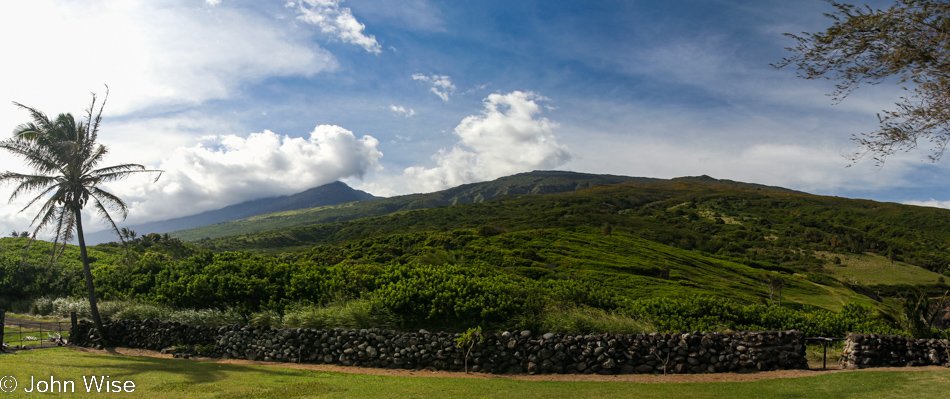
Looking inland from the church, this is the view toward the volcano of Haleakalā.

More of that white-knuckle road that I was hoping didn’t get any worse than this.

Somehow, the day is growing short with the sun starting to dig deeper into the horizon. Uncertain how long it will take us to get to the Kahului area where we are spending the night, we decide to get a move on it and try to cut short the sightseeing.

Obviously, we’ve left the primitive road we’ve been traveling since morning, and while the photos may only share a couple of dozen locations, we’ve likely not driven more than a mile or two before stopping, but I can’t share 150 photos here now, can I? I wonder if this road simply traced the old trail that might have been carved through here over time.
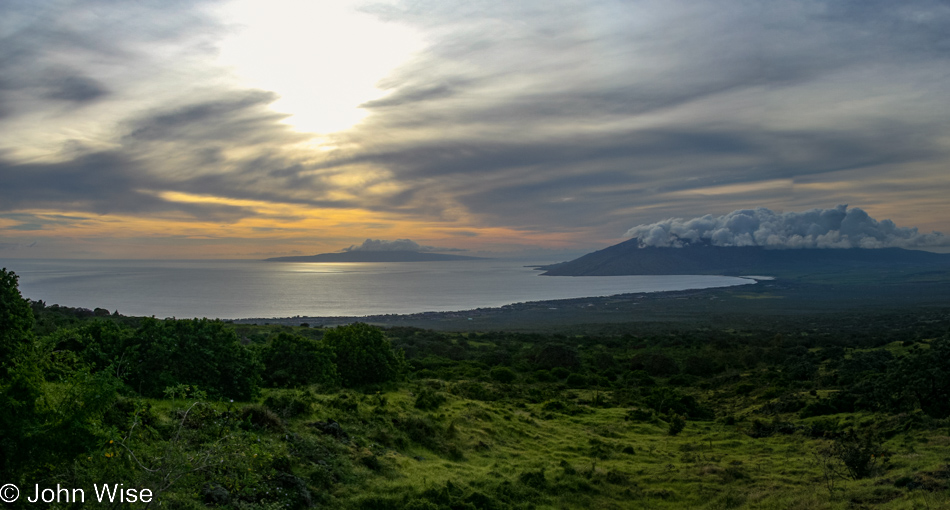
To the best of my ability to read maps, I want to say that the small island under the sun is Lanai, and to the right of it, out of view, would be Molokai.
We spent the night in the cheapest place we could find on the island, Banana Bungalow in Wailuku, for only $59 a night. Sixteen years later I see the price for a private room at this hostel is now $144 a night. And that was our first day ever on the Hawaiian island of Maui.
Aloha John,
I came across a photo of yours of Kaho’olawe Island here in Hawaii. I worked on “The Island” during the clean-up project and have started a Facebook page (www.facebook.com/KahoolaweIsland) that is intended to document the history of Kaho’olawe and is not intended for any commercial purposes. I would love to include original photography and that is why I’m writing to you. Any possibilities here? If so please contact me at: john.boyden@gmail.com
Sincerely,
John.
Hi John,
The Curriculum Research & Development Group at the University of Hawaii is currently in the works of publishing the third edition of, “A History of Hawaii,” a textbook that will be used in the public schools throughout the state. We would like to include your photo of Kahoolawe.
Do you own the copyrights to this photo? If so, what are you permission fees and cost for obtaining a high resolution digital copy? We are non-profit organization with a limited budget, and the cost of permission to use this item is an unfortunate consideration. We would greatly appreciate a waiver or reduction of copyright permission fees.
Thank you,
Amy Ngo
Editorial Assistant
University of Hawaii
Curriculum Research & Development Group
Ph: 808-956-7900